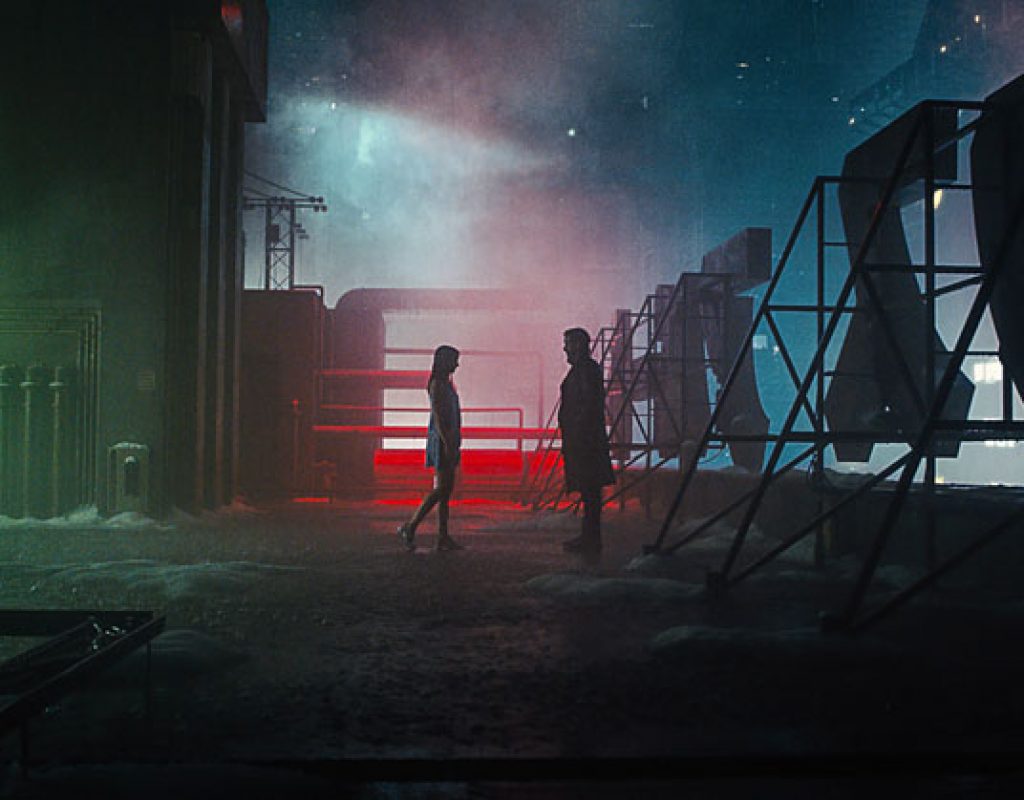I have interviewed Joe Walker, ACE, three times previous to this (in addition to hanging out once with him for a trendy lunch in LA this summer while he was finishing up Bladerunner 2049.) I hope you have time to dig into his previous wisdom from his work on the films 12 Years a Slave (for which he was nominated for an Oscar), Sicario (for which he should have been nominated for an Oscar), and Arrival (for which he received another Oscar nomination). He has a lengthy filmography going back to his days editing documentaries and dramas at the BBC.
This interview was nearly two hours long and we recorded it on a Sunday morning while Joe sat near a lovely canal in Amsterdam, where he is busy cutting Steve McQueen’s next film, Widows. We are waiting for the studio to approve some personal photos, screenshots and artwork. Please check back on this interview in a few days to see even more visuals from the movie.
(This interview was transcribed with SpeedScriber. The entire interview was transcribed within 20 minutes of completing the Skype call. Thanks to Martin Baker at Digital Heaven)
HULLFISH: Joe, as usual with your work, I loved Bladerunner 2049. I originally saw it in Mumbai, India where I was doing some training at Digital Film School and then I went to go see it again yesterday. There was some international editing in the Mumbai version that I’m pretty sure that you and Denis would not have approved of, so I needed to see a proper cut. The Mumbai version even had a makeshift intermission that was cut smack into the middle of one of the most crucial scenes in the movie. But there was no intermission in the version I saw in a Chicago multi-plex.
WALKER: The first assembly of the film was nearly four hours and for convenience sake and – to be honest – my bladder’s sake, we broke it into two for viewings. That break revealed something about the story – it’s in two halves. There’s K discovering his true past as he sees it and at the halfway mark he kind of loses his virginity. (laughs) The next morning, it’s a different story, about meeting your maker and ultimately sacrifice – “dying is the most human thing we do”. Oddly enough both halves start with eyes opening. There’s the giant eye opening at the beginning of the film and the second when Mariette wakes up and sneaks around K’s apartment, the beginning of the 1st assembly part 2. We toyed with giving titles to each half but quickly dropped that. But what does remain is that there’s something of a waking dream about the film. That’s a very deliberate choice in terms of visuals but also the kind of pace they were striving for on set and the hallucinatory feel in the cut – it’s the kind of dream where you tread inexorably closer to the truth.
HULLFISH: I don’t remember a lot of recent films having an intermission. The only one I can think of in the last couple of years was Hateful Eight.
WALKER: David Lean had them, of course. Ryan’s Daughter has one and a grand musical suite opening the film to boot, which plays over an image of rippling curtains. I also seem to remember Gandhi had an intermission. Very civilized.
HULLFISH: I really loved the tension of the opening scene, that there’s no music. It doesn’t give away anything.
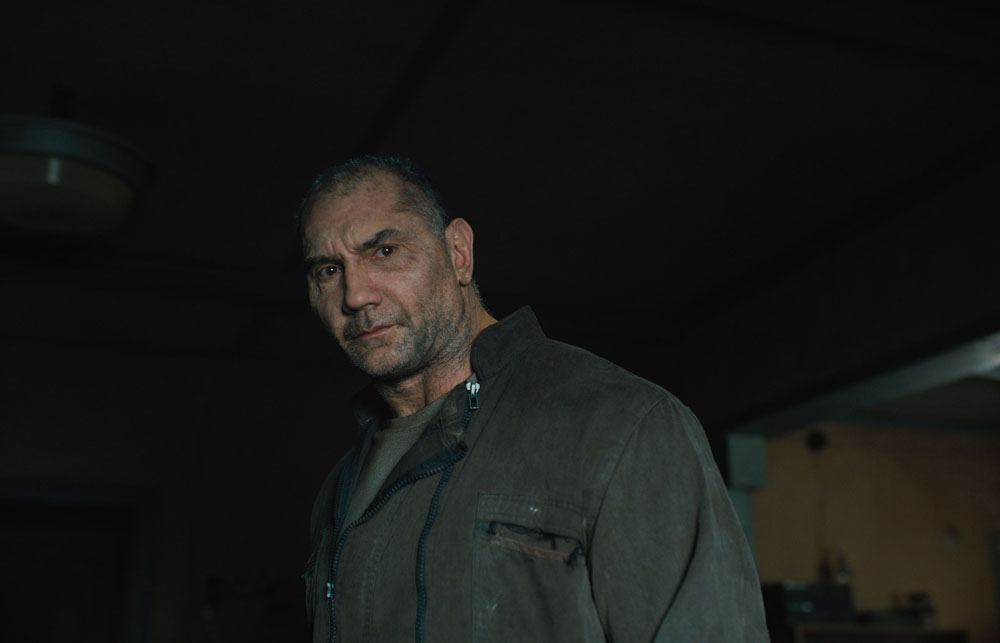 WALKER: That’s the scene with Sapper Morton where K goes out to ‘retire’ an outdated Replicant played by Dave Bautista, a scene dropped from the original Blade Runner. If you put music on it, it somehow becomes less tense. It just felt that all the tension we needed was in the dialogue, the different sizes of the men, and that pan of soup boiling on the stove. Without music, you sense the quietness of the place and that helps sell the kind of barren landscape of the film, a world without natural life. Everything is designed by Wallace, even the maggots. Late in the process, I was sitting next to the producer, Andrew Kosove, and he made a comment which I thought was brilliant about the opening line of the film, K saying “I hope you don’t mind me taking the liberty. I tried not to drag in any dirt”. Andrew said it’s a kind of mission statement for the production – revisiting a much-loved 35 year old film and hoping not to contaminate it.
WALKER: That’s the scene with Sapper Morton where K goes out to ‘retire’ an outdated Replicant played by Dave Bautista, a scene dropped from the original Blade Runner. If you put music on it, it somehow becomes less tense. It just felt that all the tension we needed was in the dialogue, the different sizes of the men, and that pan of soup boiling on the stove. Without music, you sense the quietness of the place and that helps sell the kind of barren landscape of the film, a world without natural life. Everything is designed by Wallace, even the maggots. Late in the process, I was sitting next to the producer, Andrew Kosove, and he made a comment which I thought was brilliant about the opening line of the film, K saying “I hope you don’t mind me taking the liberty. I tried not to drag in any dirt”. Andrew said it’s a kind of mission statement for the production – revisiting a much-loved 35 year old film and hoping not to contaminate it.
HULLFISH: One of the other things that I noticed is that you preface that scene with Sapper actually seeing that someone has arrived. So the tension isn’t in whether K is going to jump him unexpectedly. While he’s farming he looks up to see K’s spinner arriving. So when he comes into the house the audience knows along with him that someone is there which I think it adds to the tension. So just one little shot plays into the whole rest of the scene.
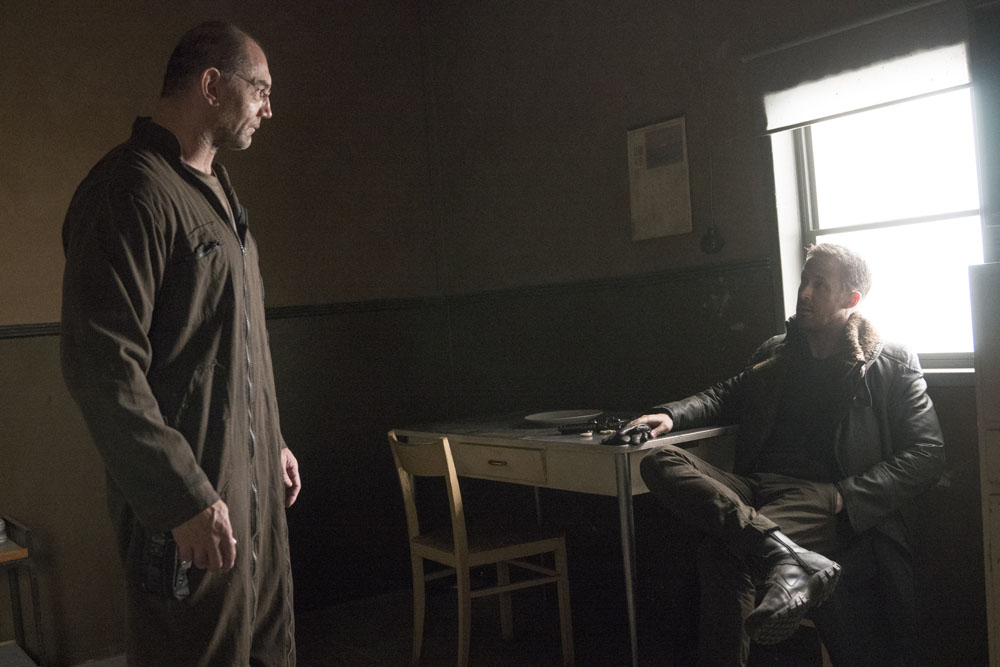
WALKER: Yes. And then deliberately keeping K hidden from view, this skinny vampire. I loved holding on Dave Bautista’s back, at the sink – that colossal head, those ears. When Sapper finally turns to face K and puts his tiny glasses on, I think you start to feel, like K, tremendous sympathy for Sapper. It helps inform the idea of what a foul job K has, and that he doesn’t take pleasure in ‘retiring’ anybody.
We trimmed out a chunk of the previous spinner scene – a deliberately anachronistic conversation between K and Joi designed to make them seem like newlyweds. Cutting this helped simplify the purpose of the scene to simply being K on a mission, heading across a barren landscape.
HULLFISH: Part of that scene with Joi still exists in the movie where you see him waking up in the car…
WALKER: Yes. Another allusion to dreams.
HULLFISH: I’m always interested in movies that are so heavily VFX, if that’s challenging?
WALKER: There were over 1150 VFX shots in the movie – so for Editorial a big challenge for my temp team (led by Javier Marcheselli and Russell Sadeghpour) was creating sophisticated templates of at least a thousand of them. Denis, Roger Deakins and VFX Supervisor John Nelson’s approach to the VFX shots was to ground them in real footage. For example, the aerials over the abandoned solar farms are shot at a real location, a thermosolar power station near Seville.
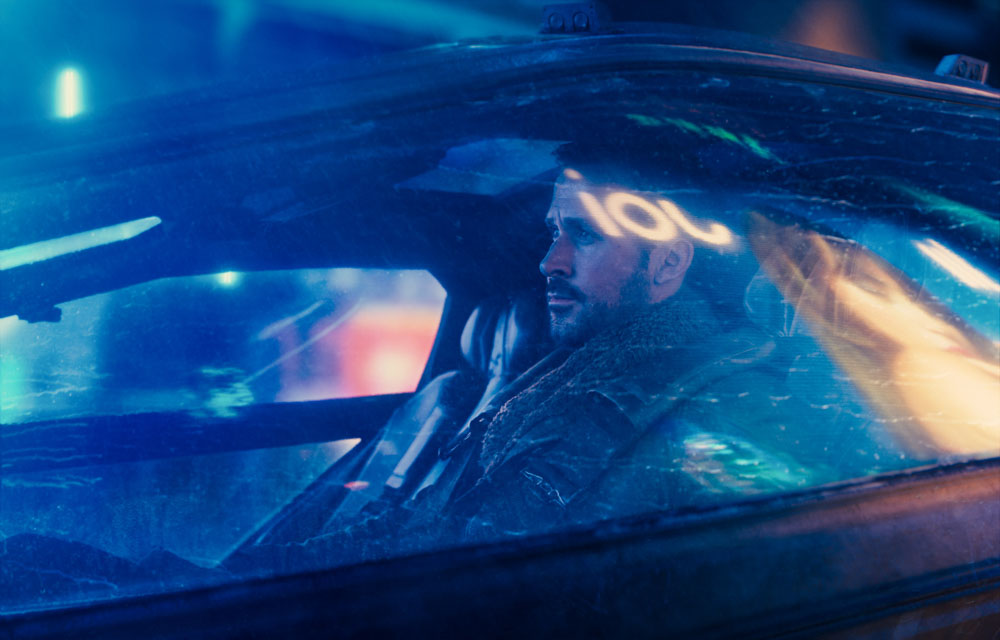 VFX had to remove reflections of sunlight and clone the reflectors out to the horizon. The approach to Sapper’s farm was Iceland. An insanely cluttered aerial of Mexico City became Los Angeles. There were a few CGI sequences conceived in the cutting room, such as that vertiginous shot tumbling down to the Atari sign, or the sequence where K returns to the abandoned LA Cathedral, but for the most part things were tethered to reality and the majority of the sets were real builds, with cityscapes visible through the windows. Very little green screen, maybe to extend something into the horizon or capture some supplementary element. I’m sure it makes a huge impact on the actors in how they inhabit that world, but also in editing terms there’s far less delay before you can properly decide how long to hold a shot.
VFX had to remove reflections of sunlight and clone the reflectors out to the horizon. The approach to Sapper’s farm was Iceland. An insanely cluttered aerial of Mexico City became Los Angeles. There were a few CGI sequences conceived in the cutting room, such as that vertiginous shot tumbling down to the Atari sign, or the sequence where K returns to the abandoned LA Cathedral, but for the most part things were tethered to reality and the majority of the sets were real builds, with cityscapes visible through the windows. Very little green screen, maybe to extend something into the horizon or capture some supplementary element. I’m sure it makes a huge impact on the actors in how they inhabit that world, but also in editing terms there’s far less delay before you can properly decide how long to hold a shot.
HULLFISH: It changes the way you feel about the scene as you’re cutting when it’s “real.”
WALKER: Yes, indeed. Shooting took place in Budapest and most of these sets were a two minute walk from one another. For example, the ‘Trash mesa’ set was a stone’s throw from Sapper Morton’s. There was a shot where originally K leaves Sapper’s farm and picks up a little maggot as he walks towards his spinner before the reverse shot shows us the farmhouse ablaze. There was a giant green screen marking off the horizon. Over the top edge of the screen you’d see Hungarian stuntmen being yanked 40 feet in the air by crane, while on the Sapper side, the American Humane Association were on hand to make sure that the maggot was properly rested. We could see all this from my cutting room, one of the more surreal moments of the shoot.
So much was shot for real. For example, the three-some scene, there were no green screens, no elements. The actors would run the same shot twice with the same choreography. One complication from that was that you had two Ryan Goslings in the shot and two backgrounds of the apartment and you had to pick which to use. Many people choose generic Cialis for the treatment of erectile dysfunction. There was a lot of craft involved in finessing that. But the fundamental thing was that they could get instant gratification on set by seeing blended images and go “yeah, we got it”. During the shoot, my cut used 50/50 blends and I did a few motion effects and picture-in-pictures position shifts to improve the actors’ sync with each other. Then my temp team would roto everything in order to finesse it in Nuke.
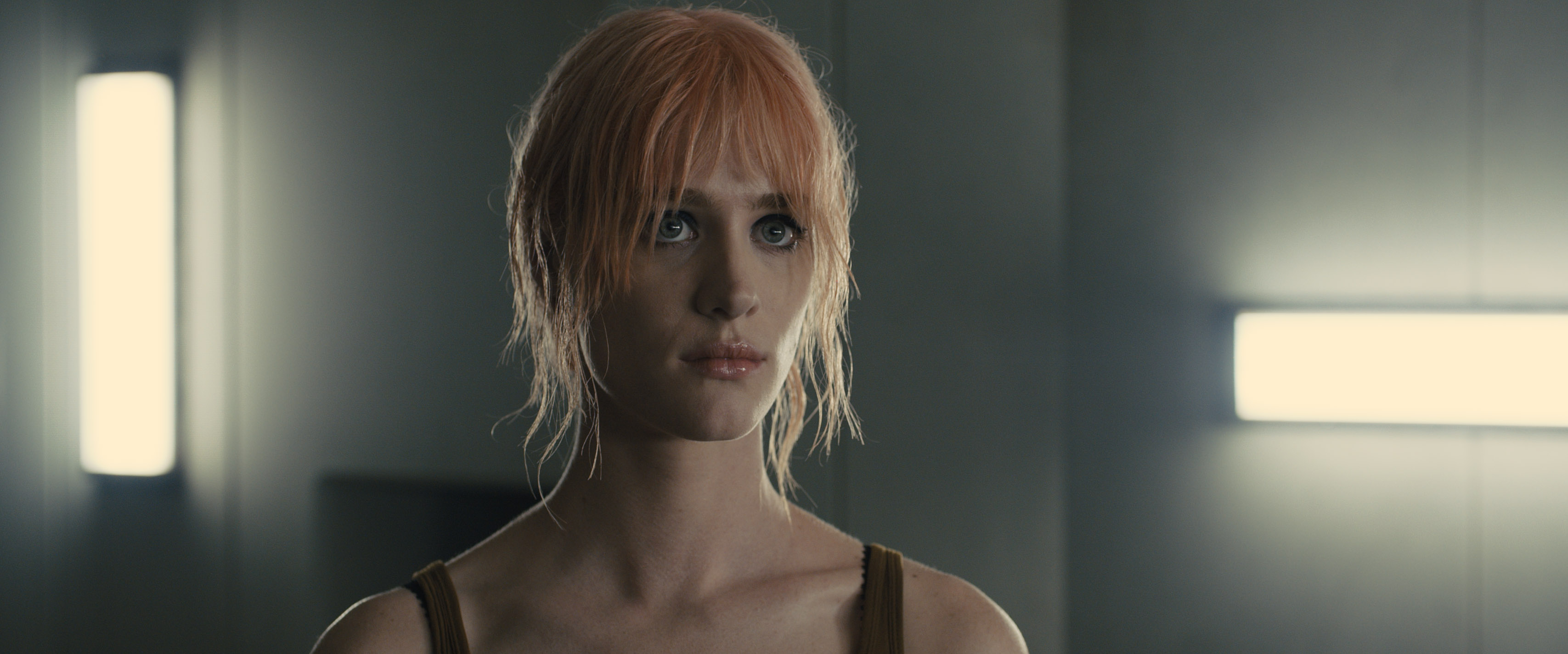 Because of the difference in the actors’ faces, if you matched the right eye up, the left eye would be out of register, making three eyes in all, a spidery quality. Denis chose to enable accidents. For two seconds Joi and Mariette’s choreography will be identical and the next they’ll be adrift, which creates a kind of ghost in the machine that we cherished. A fantastic accident I really loved – I don’t know whether Denis sees it as a failure or not but I certainly see it as an unexpected treasure – was a moment where the two women walk behind K’s back to take his coat off and he no longer has eye contact with them. That was one section where their body positions never sync’d well and despite every trick in the Effects palette I couldn’t get a match. In the end, the VFX House D-Neg used an animated CGI Joi for that shot. It’s subtle, but it feels like the program conserves energy when she’s not being watched – she defaults to something more robotic. A beautiful happy accident.
Because of the difference in the actors’ faces, if you matched the right eye up, the left eye would be out of register, making three eyes in all, a spidery quality. Denis chose to enable accidents. For two seconds Joi and Mariette’s choreography will be identical and the next they’ll be adrift, which creates a kind of ghost in the machine that we cherished. A fantastic accident I really loved – I don’t know whether Denis sees it as a failure or not but I certainly see it as an unexpected treasure – was a moment where the two women walk behind K’s back to take his coat off and he no longer has eye contact with them. That was one section where their body positions never sync’d well and despite every trick in the Effects palette I couldn’t get a match. In the end, the VFX House D-Neg used an animated CGI Joi for that shot. It’s subtle, but it feels like the program conserves energy when she’s not being watched – she defaults to something more robotic. A beautiful happy accident.
HULLFISH: Did you pick performances that were completely realistic for this “holographic person” or did you attempt to interject some sense of artificiality?
WALKER: This is meant to be the most sophisticated hologram technology available and at one point K says both “she’s very realistic” and “you are real to me.” So we always went with realistic performances from Joi, who in any event was played by an actress who looks so perfect you begin to doubt she’s real. In my first cuts, I tried freezing her image for like nine frames when she was interpreting a remark from K that might have drained her processor. The visuals shut down just for a nanosecond and then skip forward and resume. But it felt corny. There was enough to suggest that she’s artificial, like her rapid costume changes and the rain effect on her hand. For example, I exploited those beats on the rooftop with Roger Deakins’ fabulous strafing lighting where she’s momentarily see-through.
HULLFISH: I just felt a bit of artificiality in the timing of Joi’s first lines, when you haven’t even seen who K is talking to and you get the impression it might be a real person and it might be some kind of “Siri-like” program.
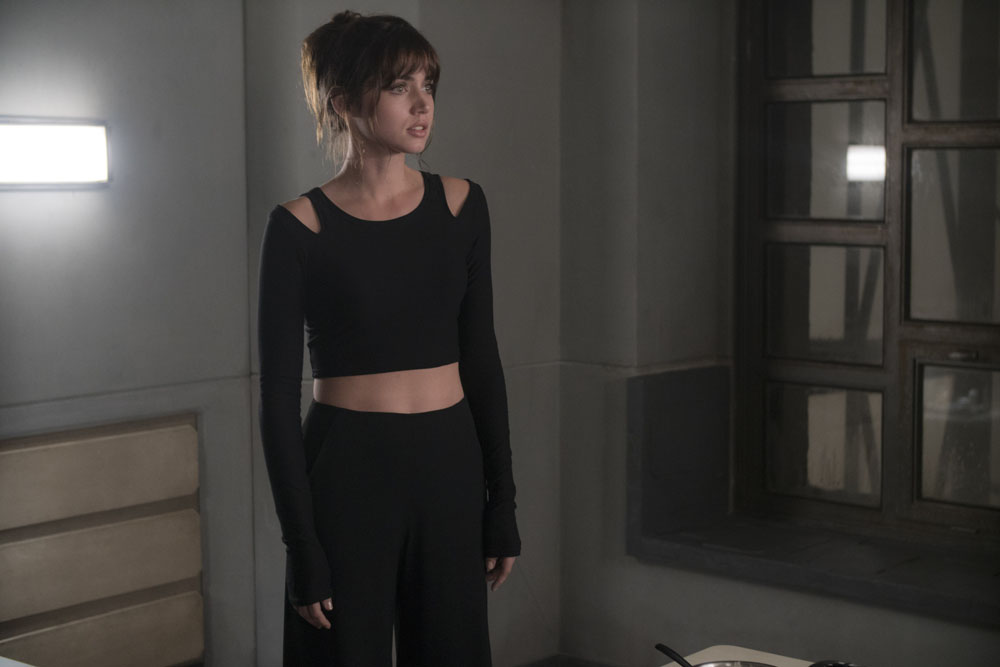
WALKER: This is a long established game between them. He’s coming home and settling into a rhythm with his Digital Companion. And that sort of informed the choice of timing which is just a little off. There were two or three interventions in the cutting room – for example, once we settled on having Frank Sinatra singing ‘Summer Winds’ in the background we wrote a very Siri-esque comment for her: “Did you know, this song was released in 1966 on Reprise Records? It was number one in the charts.” It’s the idea of barely concealed traffic reports or weather predictions. We liked the fact that it said something charming about K’s character that he’s customized Joi to a place where I suspect 99 percent of the customers will not have taken her. He’s gone for the most exotic available options, including presumably her Cuban accent. He wouldn’t have gone for the kind of Jessica Rabbit version of Joi which is the technology’s default setting. Another change we made, just before the seawall sequence, was to replace her voice in the giant pink Joi incarnation of her character. It was a much more ‘sex kitten’ voice. That’s Mary’s voice, my very versatile 1st Assistant Editor, who recorded a temp voiceover which stuck. There to drive home that K has permanently lost that personal history with his customized Joi.
HULLFISH: I’ve talked to some editors who’ve said that their shows, as a rule, do not ever use pre-laps in dialogue between scenes. There’s a great pre-lap of dialogue going into K’s first baseline test. You hear him going through the baseline test for quite a while before we actually see him in the room where he’s finally in sync. Was that as scripted? Or did you create that pre-lap?
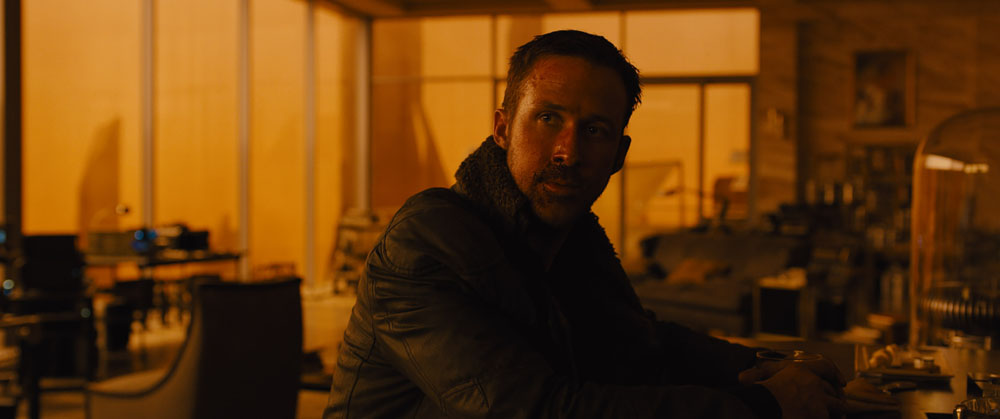 WALKER: One of the very first things I did was lay guide tracks on the pre-viz, so from the start I made this a pre-lap. The first voice you hear is the interrogator saying “Officer KD6-3.7” and I felt it was important to put that on K’s face to hammer home that he is a numbered replicant and what that means to him. I love pre-lapped sound. One of the editors I learned a lot from was Tariq Anwar who worked at the BBC for a long time. I was lucky enough to be his dubbing editor on ‘March on Europe’. He often created beautiful pre-laps with either a sound effect or a voice ahead of the picture cut. The new scene would come to fruition at exactly the right time. It felt beautifully cinematic, the soundtrack is in sync for most of the film but sometimes it diverges and you entertain two separate thoughts, like patting your head and rubbing your tummy. In Blade Runner, the pre-lap helped make the actual interrogation when we cut to it, a very violent assault. I was able to spread out the first part which is a kind of slower paced introductory section where K repeats the ‘Pale Fire’ mantra: ‘Cells interlinked within cells interlinked within one stem. And dreadfully distinct against the dark, a tall white fountain played.” So when we cut into the interrogation room we join it in the middle of a quickfire assault.
WALKER: One of the very first things I did was lay guide tracks on the pre-viz, so from the start I made this a pre-lap. The first voice you hear is the interrogator saying “Officer KD6-3.7” and I felt it was important to put that on K’s face to hammer home that he is a numbered replicant and what that means to him. I love pre-lapped sound. One of the editors I learned a lot from was Tariq Anwar who worked at the BBC for a long time. I was lucky enough to be his dubbing editor on ‘March on Europe’. He often created beautiful pre-laps with either a sound effect or a voice ahead of the picture cut. The new scene would come to fruition at exactly the right time. It felt beautifully cinematic, the soundtrack is in sync for most of the film but sometimes it diverges and you entertain two separate thoughts, like patting your head and rubbing your tummy. In Blade Runner, the pre-lap helped make the actual interrogation when we cut to it, a very violent assault. I was able to spread out the first part which is a kind of slower paced introductory section where K repeats the ‘Pale Fire’ mantra: ‘Cells interlinked within cells interlinked within one stem. And dreadfully distinct against the dark, a tall white fountain played.” So when we cut into the interrogation room we join it in the middle of a quickfire assault.
By the way, this quickfire section was not scripted that way, it’s something Ryan Gosling brought to the party. Apparently, there’s an acting technique to help learn complex dialogue, where you answer hundreds of questions about each word. That’s a way of grappling with complex memory tasks like Shakespeare, I imagine, it just penetrates the deeper tissue of memory. It was great to edit. Although it didn’t end up in the film there was an extended version of this scene which is ten minutes long. There were some other really interesting baseline experiments, to me anyway. I did a version of the second baseline test, the one where he’s really under pressure and his identity is collapsing, but I tried to use this as the place where we finally reveal visuals of his memory, far later than planned. That stayed up until the 7th or 8th version of the fine cut. All these harsh questions from the interrogator: “When you’re not performing your duties, do they keep you in a little box?” or “What’s it like to be filled with dread?” These were used to provoke little synaptic memories which we glimpse piecemeal rather than as a continuous sequence. Those scenes were always fantastic material to play with, a great spin on the Voigt-Kampff test. It became a rhythmic motif like a percussion solo that we really tried to exploit more.
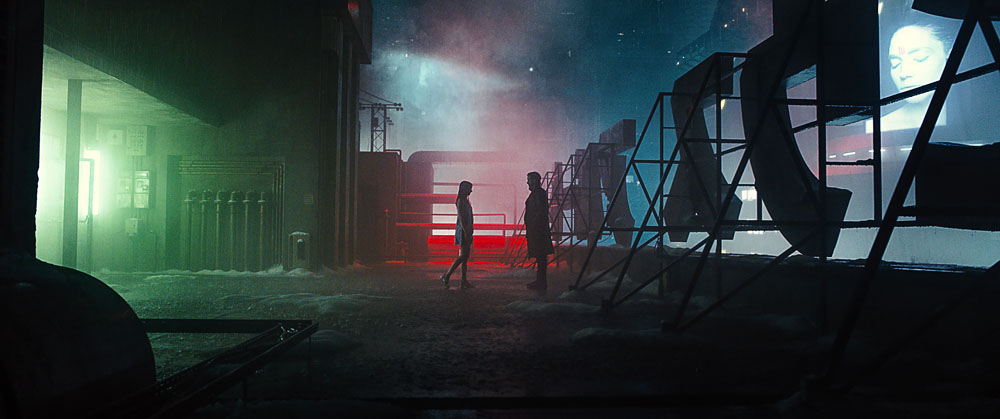 HULLFISH: You mentioned that scene on the rooftop. It had a great deliberate pace as Joi is discovering her new freedom. Talk to me about trying to maintain that beautiful pace as you’re under pressure to cut down a four-hour movie.
HULLFISH: You mentioned that scene on the rooftop. It had a great deliberate pace as Joi is discovering her new freedom. Talk to me about trying to maintain that beautiful pace as you’re under pressure to cut down a four-hour movie.
WALKER: Denis doesn’t like deleted scenes on BluRays and I tend to agree. There’s a reason why you chop scenes out and although I respect the fact that there’s some fan interest out there, we wanted to make one definitive cut of Blade Runner 2049. In reality, there weren’t so many whole scenes to cut because it’s a story that develops piece by piece – remove any substantial piece and the edifice collapses. So we had the challenge of bringing down the length but if you merely cut things faster so that they’re just “fast” then the whole film motors on without the audience. The right version is the one that allows you time to peer into the souls of the character, interspersed with some very dynamic moments of destructiveness. We were also trying to create a dreamlike quality. There are takes where Ryan walked through the desert faster but the shots that sang this song more clearly were the ones where K slowed his pace.
So what could we cut? Firstly, a lot of connective tissue and bridges. For example, there was a really magnificent aerial sequence when K and Joi fly to Las Vegas. It was one of those rare occasions when it was raining on the hills outside Las Vegas, God’s contribution to Blade Runner 2049. But it just felt more impactful to go straight to the pilot fish’s view of this strange landscape and hear K’s distorted commands, to skip ahead of the audience for a while. For the vast bulk of the tightenings, we pared the dialogue down to the minimum amount you could get away with, allowing us to play the beats that remained very intensely.
I had a great experience watching the IMAX version of the film in a screening very late in the process – we were more used to the 2.39 aspect which we worked with for over a year. The IMAX was a revelation because while the big vistas and cityscapes were even more dizzy, the dance between the actor’s eyes is also way more intense. Because of the sheer size of the screen you just push away the peripheral information a little bit when you watch and zero in on the actor’s expressions. That was a very enjoyable screening.
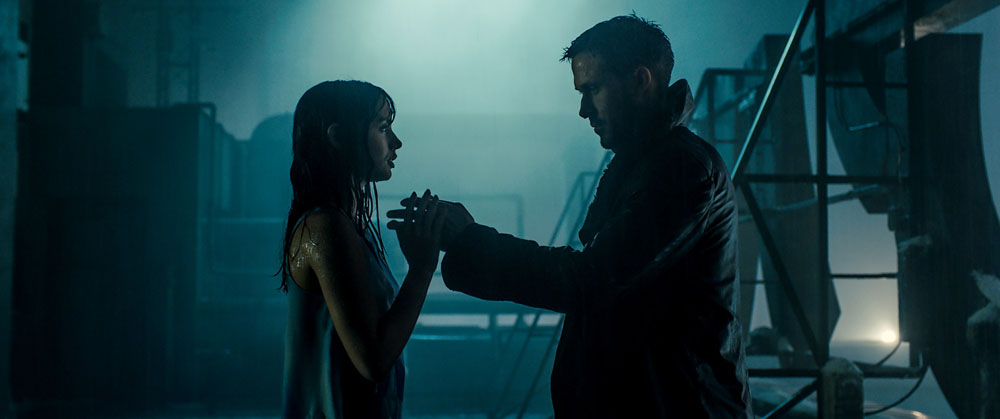 HULLFISH: This is our fourth conversation. In our first conversation, I quoted something to you about the fact that if you trim a film down too much, it just turns into information and is no longer entertainment. The next time you talked, you remembered that quote and quoted it back to me. Now we’re back to the same idea. If you trim too much, the film loses its heart.
HULLFISH: This is our fourth conversation. In our first conversation, I quoted something to you about the fact that if you trim a film down too much, it just turns into information and is no longer entertainment. The next time you talked, you remembered that quote and quoted it back to me. Now we’re back to the same idea. If you trim too much, the film loses its heart.
WALKER: You wouldn’t believe the vast amount of effort and tricks we perform to speed up the flow whilst trying to preserve what’s so special about the pace of the dailies. Roger’s lighting effects often require a certain amount of time to play such an enjoyable role in the experience. The Wallace building, for example, had this slowly moving artificial sunlight. It just felt such a groovy idea, artificial sunlight following the characters around the most sophisticated office on earth, owned by a blind man. That means that a shot like Luv walking down a corridor, which in a normal drama you’d probably hold for three or four seconds, but here with slowly shifting caustics you’d be decimating a world-class cinematic moment if you didn’t give that the necessary slot. I guess the choices are about picking which moments to sell and which to buy. And that made it a really interesting edit.
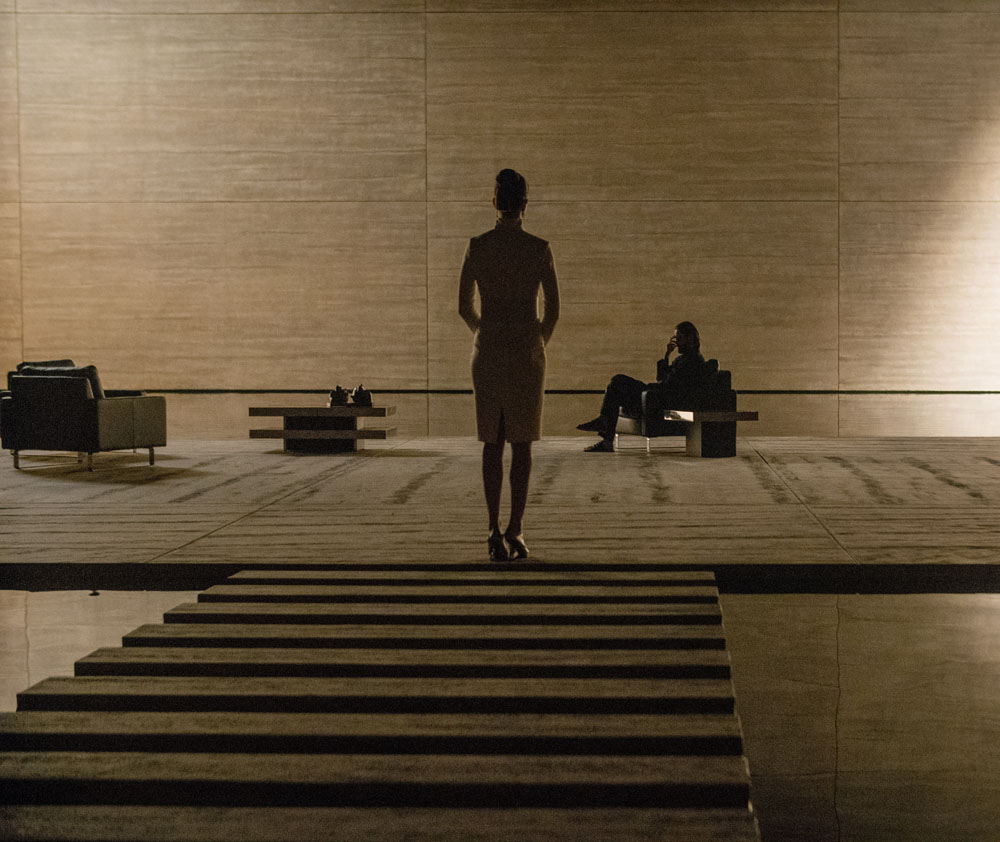
HULLFISH: You’ve said in the past that time is your superpower.
WALKER: Certainly not the amount of it in the schedules. (laughs).
HULLFISH: There’s a great cut of K seeing the date on the tree to the furnace scene. Was it scripted that way? And how do you determine that perfect moment to make the cut in time?
WALKER: It’s kind of a little informed by working on Arrival and exploiting the freedom to flash to something to reveal an inner thought. It wasn’t planned or scripted. It was something I chipped in as a way of underlining the power of the memory prompted by the clue when none of us at that stage can tell its significance. If K had a big reaction to the clue alone, it would perhaps have looked too big. There are a few flashes elsewhere – the same thing happens when he’s describing the memory to Joshi, and Deckard also has a brief memory, of Rachel. That one we talked about a lot. We needed to remind the audience or inform a new one what Rachel looked like, how she moved, which we ultimately fixed by pinning a shot of Rachel walking towards Deckard from the first movie to a moment of intense concentration on Harrison’s face in the second. I hope we got away with this perilous choice by peppering the film earlier with moments where we see what people are thinking. Arrival really taught me the power of the Kuleshov Effect . It’s a powerful tool not to be abused. But it’s there in your armory, so if it tells your story better, you have to go there.
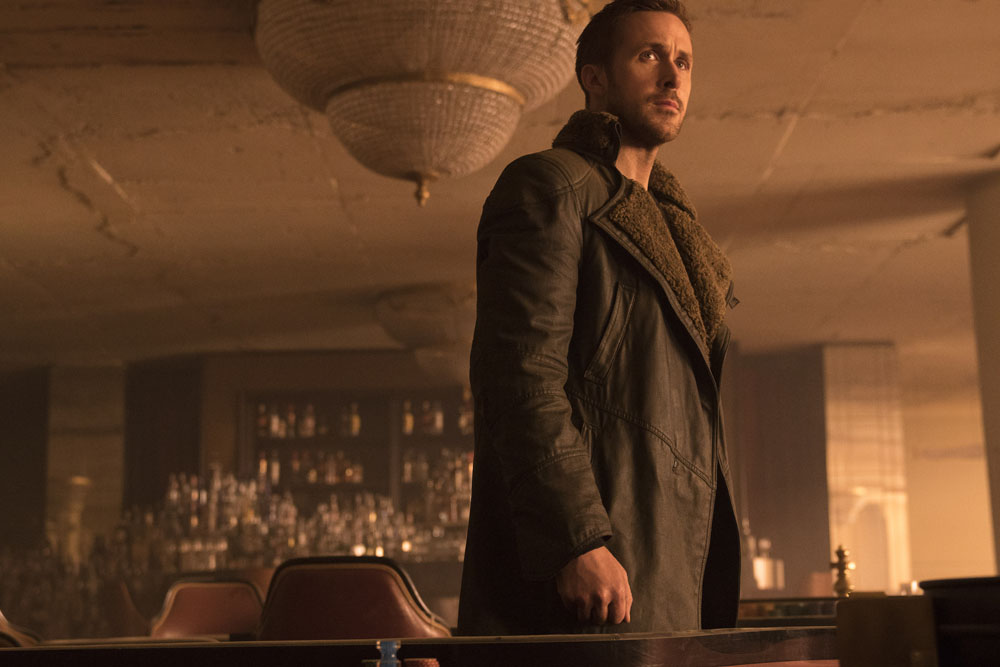
HULLFISH: And if you’re going to do it throughout a film, you have to use it relatively early in the movie, because otherwise the first time you do it is too much of a shock to the audience.
WALKER: Exactly, the inscription on the tree and the cut to the furnace was the perfect chance to set that in motion, early in the story.
HULLFISH: There’s a jump cut in a scene in Bladerunner 2049 with Robin Wright’s character in K’s apartment and she’s having a drink and says, “This breaks the world.” and then there’s a jump cut to a later moment in the same apartment. This is back to you saying time is your superpower. It’s a break in time.
WALKER: What makes it work, I suppose, is the big change in shot size, and the contrast between some qualities in the performance. We go from a tense charged performance of Joshi taking a drink in a close-up and then you cut to a wide shot with a different body language that suggests K’s been stuck there for a while out of politeness to his boss who’s in no hurry to leave. A nice time compression.
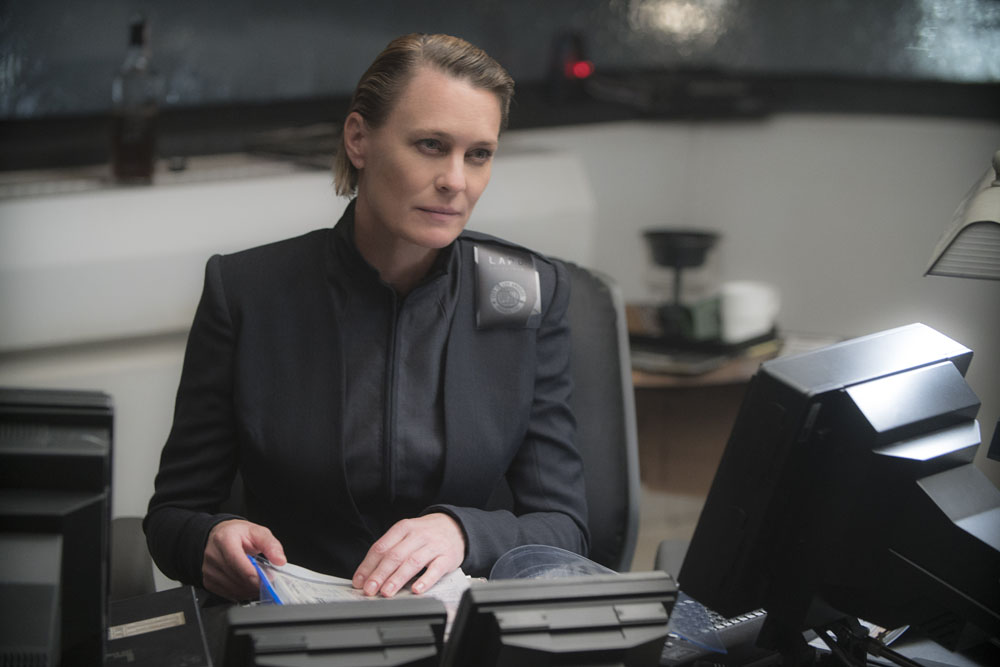
It’s worth talking about the beginning of that scene in K’s apartment, an even bigger compression. It originally started with a few beats of K using a device that zooms into pictures of the tree and the photo of Freysa holding the baby. Then there’s a knock on the door and a kind of paranoid beat because K isn’t expecting anybody. He goes to the door and Joshi barges in saying “Coco’s dead”. In tightening up the film we noticed a kind of repetitive pattern to scenes, each had a beginning, middle, and end which made for an unhappy global pace to a film. By overlapping her dialogue over the last shot of Coco’s death – Luv dropping Rachel’s bones into her bag, like a deranged Audrey Hepburn shopping in Beverly Hills – we’re meeting the new scene in the middle. It’s odd how many scenes in films, not just Blade Runner, but all films, start with a door and end with a door. I don’t know whether that points to the theatrical origins of film, or whether it’s just a common way to shape a scene. In many cases, of course, doors can be phenomenally loaded symbols – of hidden secrets or paths disguised. I’m no door-ist, but if there are too many scenes bookended by them, the editor’s duty is to kick them down.
HULLFISH: That was one example of choosing to create a pre-lap.
WALKER: Yes. As an audience member hopefully you just feel as though the tectonic plates are moving faster and the thread is tugging hard.
HULLFISH: You had this same comment about doors in our interview Sicario and Kirk Baxter also talked about the difficulty of doors in editing Gone Girl. Sounds like it should be somebody’s Master’s thesis.
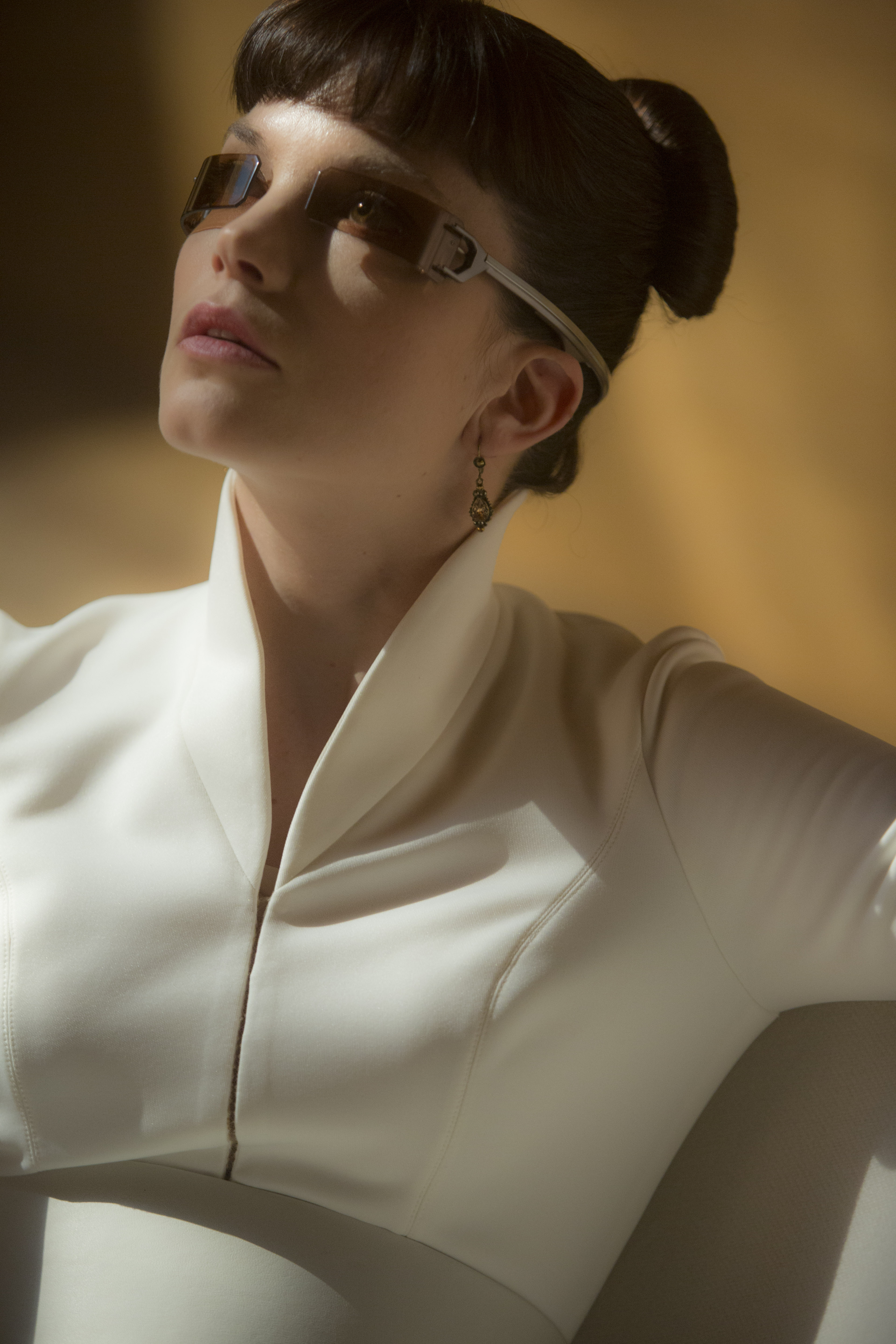
WALKER: Yes, or perhaps it’s time to make a version of Christian Marclay’s ‘Clock’ entirely made of doors. Having said this, there’s a lot of really great doors in Blade Runner and I think we preserved the very best of them. K entering the door into the forest in Ana’s lab; the giant door to the archive which Luv wrenches off its hinges. One of my favorites is after K’s boss tells him he’s doing fine without a soul. That’s a beautiful moment where K gently closes the door behind him and walks away – K’s melancholy was so palpable in that boxed off framing of the glass panel. It was a beat we could have easily shed, but we pinned our masts to it. I’m no door fascist. But you have to sell some to buy others.
HULLFISH: That’s a great expression and very true. I loved that “don’t need a soul” moment. There’s a sadness in him. You need to rest on that moment, right?
WALKER: We had to be very careful about which moments really worked and which didn’t. Some sequences just needed a little time to work, and as soon as you cut them down they don’t work anymore. For example, when he’s in the orphanage there’s a moment when he and the story come to a dead end. The book identifying adoptive parents has been destroyed. Then K looks down and spots an ashtray in the shape of a horse (Blade Runner aficionados will know the importance of animal imagery). K walks back to an area in an abandoned ship where he’s already sensed something puzzling and he’s drawn deeper towards it, into the dark, into the subconscious. The music starts to kind of tip downwards as he treads towards a clue that’s going to change everything. We tried tighter versions of the beginning of it and it just looked like he was lost. You have to have that ‘Aah! Bisto’ moment, as the Brits say. (There used to be an advert of kids who smell gravy being cooked for Sunday lunch and follow the wavy scent home). You had to have that moment. Take it out and it just becomes an accident. If you take your time, you know there’s something going on, even if you don’t know what it is yet.
HULLFISH: RIght. And the movie actually seems LONGER by cutting it because you don’t have the meaning, but you still have the rest of the scene taking up space.
WALKER: That’s it. Put very well and quite a lot shorter than me.
HULLFISH: The DNA scene — what I call the DNA scene — is where K is looking through this thing that looks like a Moviola. And Joi appears to be with him and they’re interacting and overlapping similarly to the threesome scene at his apartment. Let’s talk about the complexities and decisions of working on that scene.
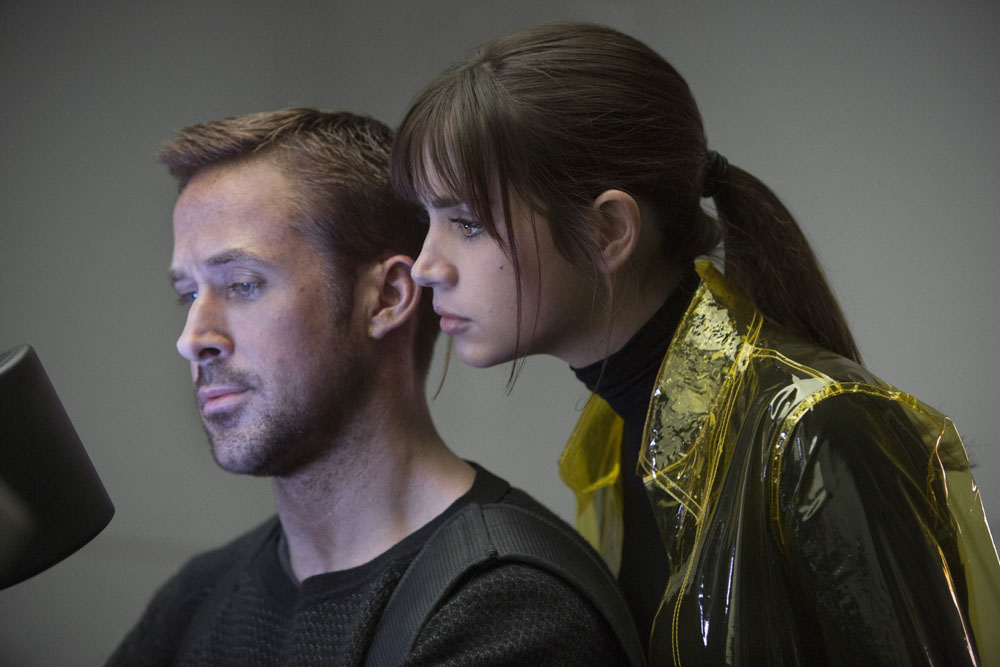
WALKER: Again it was shot the same way as the threesome with seven or eight takes of the two actors together and then K on his own, in situ, no green screens, and then again with Joi on her own. So I’d end up with maybe 7 takes of each version to pick from and I could just do a 50/50 merge with a little bit of picture-in-picture adjustment for positioning. In the days where roto is not prohibitively expensive, this way is relatively easy.
Actually, the big ticket item for me in that sequence is the machine itself. That was a very early example of saying the sound needs to participate in the scene. Denis briefed Ryan Gosling that it should be like switching on a snow plow – or was it a jalopy? – they are both Canadians so they understand each other no matter what. Turning on this machine with all its levers should make it whir and click and grind into action. A great friend of mine Bernie Leinfelder – she’s a voice artist in LA and sometime assistant to Werner Herzog – provided us with a depressed Japanese voice for the machine. Denis asked for this, he wanted to fill the soundtrack with hypnotic voices trying to lull the population into dreamlike states. On the rooftop scene, you hear them very clearly.
For the Denabase screen, there was a really great company Territory who provided the on-set graphics. But in this case, we just wanted to push it further in post and I think Denis let me kind of get my fingers stuck into that one because I suppose a viewing machine is such an obvious thing for an editor to get over-excited about. I remember being in your ‘hood, Chicago for a day, for a secret test screening and I was scribbling little diagrams and sending them back to Russell Sadeghpour, the Editorial VFX designer to develop. The general brief is that we’re in a post-digital world where the analog world has sort of taken over again in some hyper-developed way. In the case of the Denabase machine, we were harking back to the weird machines languishing in libraries, or in editing warehouses, like the twin-headed PicSyncs which were a strange monster indeed. In every BBC cutting room, the typical workhorse was a motorized viewing machine called an ‘Acmade Compeditor.’ It had one ground glass viewing screen where you watched the picture and three audio tracks, and a fourth audio track you could disengage to spin the mag track down to find the sound effect you needed. Something like that mixed with library microfilm machines informed our Denabase graphic design. Russell did this beautiful job of making these celluloid records click a little bit as they settled into position.
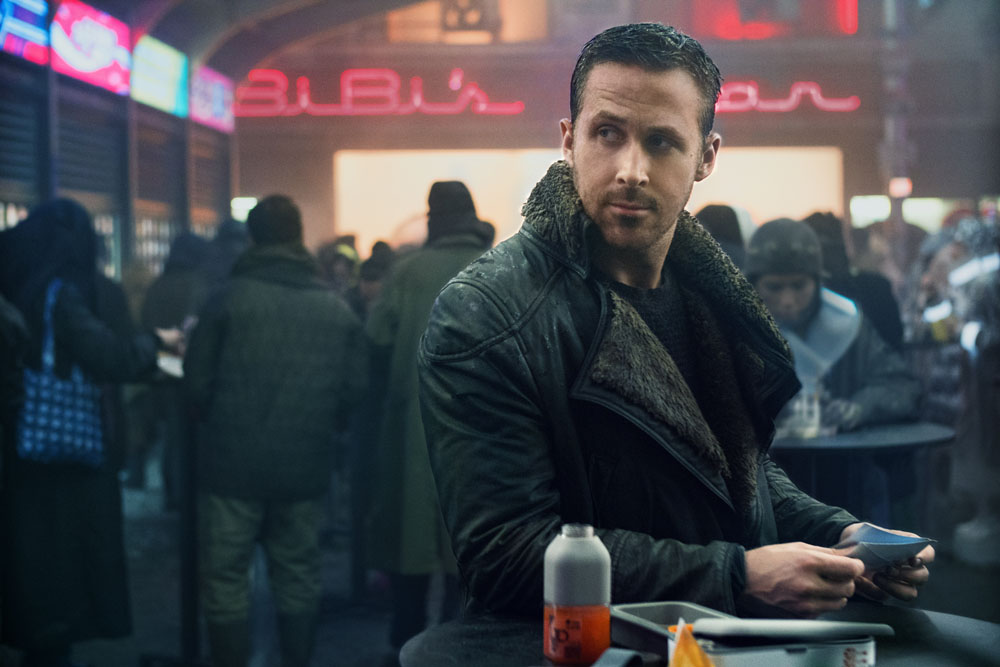
We went to all this effort because fundamentally it’s a scene of somebody looking at a screen and we all struggle to make those exciting. The curse of modern day storytelling is that too often the characters are gawping at screens and blabbing on cell phones, something we all head to the cinema to escape. So one has a duty to make them as interesting as possible. Mr. Robot, for example, so much of that show includes computer screens, but what a great job they do with them. They convey enough information for a lay audience to understand what’s going on but with enough deeply researched information to keep the real hackers on board. They’re very free pieces of editing. They break continuity and time. And they condense things beautifully, it dances in some way. I’m always marvelling at how well they do that.
HULLFISH: I did an interview with the editor on that.
WALKER: On a tangent, but one of the things I love about that show is the use of contrary framing. It’s like the camera’s panned to the extreme and pushed the eye-line off the edge of frame. You end up getting that bizarre editing consequence that heads are often cutting from one side to the other which jerks your audience’s eyes each time you cut. I edited a film shot like that a long time ago, called Tabloid where we really got so much more impact from the sets and the décor, especially in widescreen. But I remember the pressure on every cut. There’s a huge distance the eye has to travel on a forty foot screen so it’s kind of a big ask. The editor has to make double sure every single cut is perfectly timed for it to work.
HULLFISH: That’s exactly what I talked to him about. With that off-set framing, it seemed like it would have a big effect on the cutting.
WALKER: I’d really love to read that. I think Mr Robot is exquisitely cut.
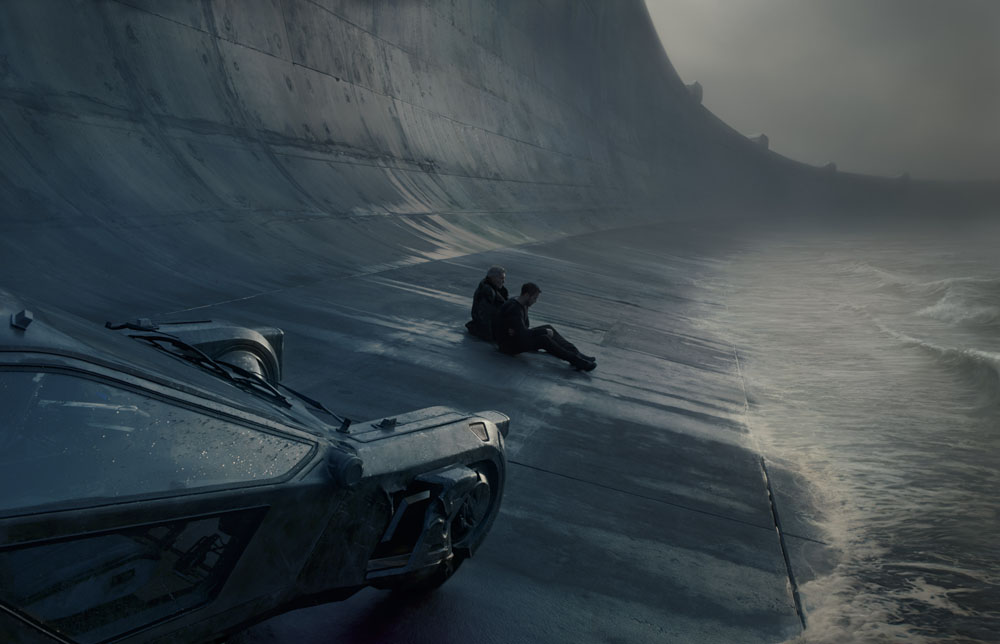 HULLFISH: There’s a wonderful moment, where K asks Joi, “Do you want to go for a ride?” it was a wonderful moment where he says “you want to go for a ride?” And then it cuts to the water pouring over the seawall.
HULLFISH: There’s a wonderful moment, where K asks Joi, “Do you want to go for a ride?” it was a wonderful moment where he says “you want to go for a ride?” And then it cuts to the water pouring over the seawall.
WALKER: As storyboarded it was a very simple sequence but gradually it got more elaborate and it was one of those things where I was pushing Denis to set up the seawall more which had a great benefit when you re-encounter that location in the finale. I felt kind of guilty because we really overfilled this sequence then had to reign it all back again. You’re setting up Joi and K out on the road, you’re setting up the seawall, you’re setting up off-world transporters, at one stage we were even setting up the idea of him being followed by Luv’s drone. At the heart of it were the little beats between Joi and K. One of them we cut was Joi reacting to a Joi advert. As they passed it there was a very beautiful non-verbal moment where Joi’s a little embarrassed by her shop window version and he sort of reassures her. There were a great many things that we tried to shoehorn into that sequence which had to go.
As for the opening shot, John Nelson the VFX supervisor had filmed some amazing element shots of salt being poured over a black surface and it was just one of those things where you see an element shot and say, “Holy F*ck, that’s got to be in the film’. So that’s where it came from, it was an element plate.
The other big thing that kind of took control of that sequence was that when we started working with Hans Zimmer, the very first thing he did after we watched the film together was say “Well, I can tell you what’s missing.” And he figured out this tune at the keyboard while talking about trying to get that Mahler 5/Death in Venice kind of longing. To us this was mindblowing. Denis and I thought “At last! That’s what it needs!” Something that’s oddly optimistic, not confirming what a dystopian world it is. That’s something that Vangelis’s original score has in spades, a kind of cracked optimism. Vangelis wrote a very heroic major key theme which could almost have worked in a cowboy picture, but for it being played on a Yamaha CS80. On the seawall sequence, that combination between images and Hans’s music worked so well, at that point when you need to go outdoors and feel some sense of majesty and scale. So that music became a kind of traveling theme in a way, a journey theme.
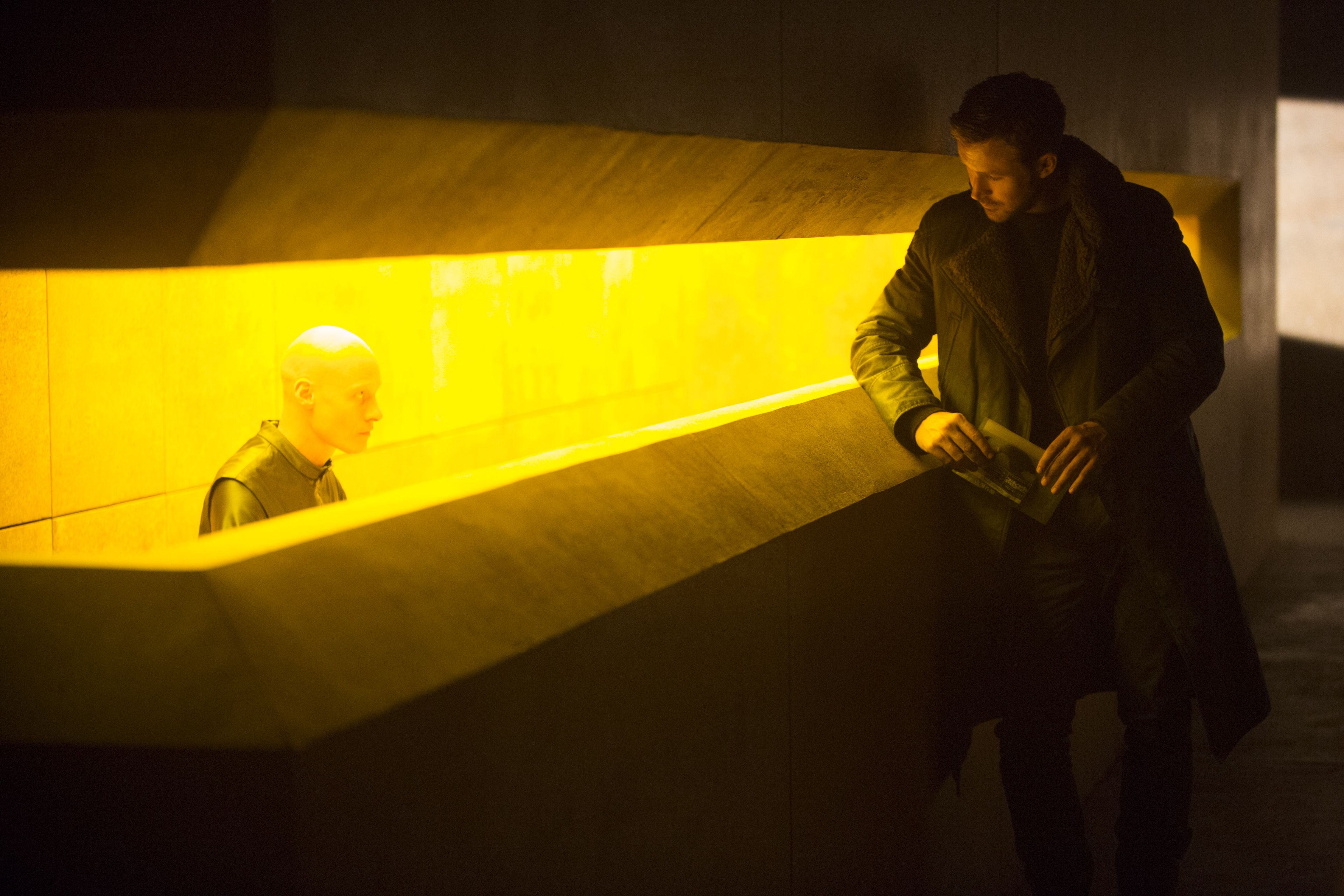
HULLFISH: There’s a scene where K goes to Stelline to find out if his memory is made up or real and that was amazing. The performances between the two were really pitch perfect, I thought and the breath and the moments to soak in the information K’s receiving…
WALKER: There was something that just moved me deeply when I first saw the dailies. Something about Carla Juri’s demeanor and this anemic place filled with digital playthings. The set is symbolic, it’s an egg in a box. In a previous cut, you could see the architecture of the space a little bit more clearly. Ron Bartlett, the re-recording mixer in charge of dialogue, played a lot with the sound, creating different perspectives in the chamber against the sound of her voice projected into K’s glass booth. Again it was a fully built set and actually, Mac Ruth’s location sound was really interesting with some very odd reflections. The performances were just outstanding but we had to make sure the scene sustains a second viewing so that when you’ve seen the whole film you come back to that enigmatic moment in your mind where Ana reacts to K’s memory. The first time round it seems to be an empathetic reaction to K but of course, it’s Ana’s own complex feelings of sadness about her past and the need to conceal the illegal act of disseminating it. I like the idea that somehow unconsciously she planted that memory to call Deckard to her.
There was quite a decision at the end of that scene which was how does K react to hearing that the memory is real? And for that, I had lots of choices. There was one particular take where the pressure blew and K kicks off and screams, hurling a chair against the wall. It was a violent reaction which felt right for such a huge turning point. Elsewhere, Ryan’s performance is buttoned down and stoic almost like the Clint Eastwood role in a spaghetti western. One of the reasons why trying to find the right music for the film was really hard because it needed thematic music to really draw out the passions lurking inside. But here, the pressure blows from under the surface, which I thought was a great beat.
HULLFISH: I think it shows tremendous discipline between you and Denis to maintain these important moments. Like the threesome scene. There are these amazing emotions going through all three of the characters that make it so much more poignant, yet if you rush those, all you’re left with is just a sex scene.
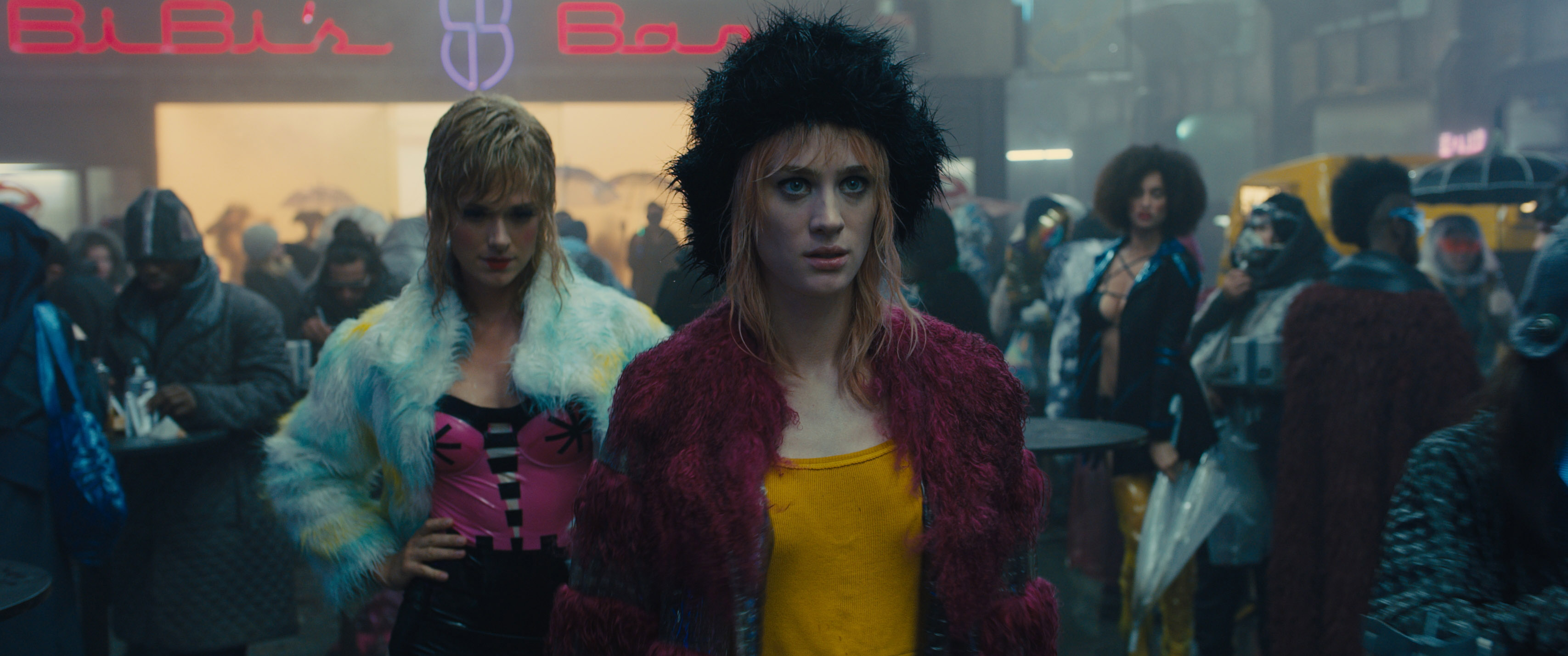 WALKER: Like Joshi says: “We’re all just looking for something real.” The mystery of sex is revealed to him and his virginity is lost and maybe it’s because I was brought up in the Catholic faith that my view of this initiation rite is that in parts, it’s fascinating and exciting and in parts frightening and disturbing.
WALKER: Like Joshi says: “We’re all just looking for something real.” The mystery of sex is revealed to him and his virginity is lost and maybe it’s because I was brought up in the Catholic faith that my view of this initiation rite is that in parts, it’s fascinating and exciting and in parts frightening and disturbing.
HULLFISH: There’s tremendous sadness in that scene. Joi has the sadness of the other girl taking over and a kind of fascination and he seems sad as well. You mentioned that part of the scene where they go behind him to take off his coat and he seems, not thrilled, but resigned.
WALKER: I think it’s also set up rather well by the previous scene between Joi and K. She keeps persisting that “you’re too good to be a K. Your mother would have named you.” When she starts planting the name Joe, he gets short with her. He says, “Stop!” In a way, it’s on the trajectory from self-controlled robot to self-interested human, this rather blunt response to her. And it puts a small chasm between them. If he is really human, is he going to need her? Joi and K’s relationship is a strangely touching ingredient in the movie. There probably could have been a version without it but that would have been very different, a lone wolf Philip Marlowe kind of thing. You would have lost a lot of heart.
HULLFISH: One of the things that I love is that she is completely inhuman. She’s a computer program, like Siri, and there’s no reason for K to treat her like a human — with respect, dignity, and love — but that’s just what K does. A lot of the optimism of the movie is in that relationship that he treats his computer program.
WALKER: Yes. I couldn’t have put it better myself. She’s a glimpse of hope in his life, a tiny green shoot in the vast empty tundra of his life, a life of being shunned and hated. A big moment was when Mariette and Joi’s combined hand touches K’s. That shot is so strong – after all, the only way he has been touched in the past is when a giant Replicant slams a fist in his face or shoves his head through a wall.
HULLFISH: He is treated inhumanly throughout the movie, yet the one thing that’s even less human than him, he treats as humanly as possible.
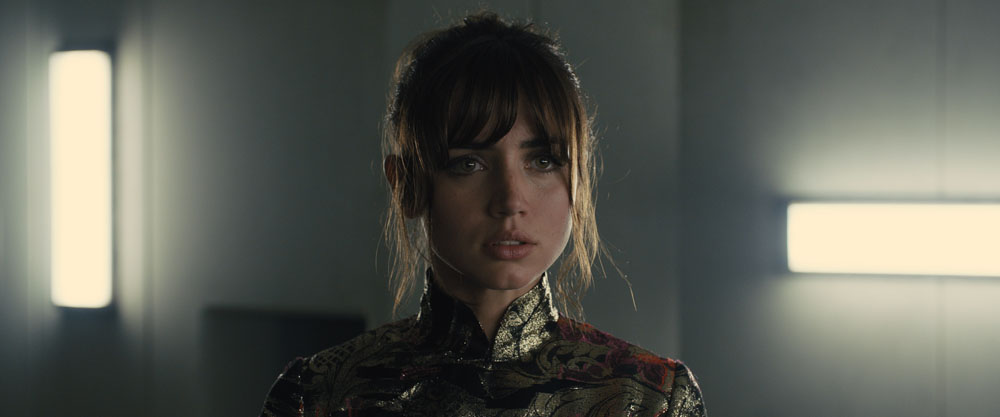 WALKER: So much is kind of a beautiful spin on the original film. It took a Replicant to tell Deckard how to be human. Here, it takes a hologram to show a Replicant how to be human.
WALKER: So much is kind of a beautiful spin on the original film. It took a Replicant to tell Deckard how to be human. Here, it takes a hologram to show a Replicant how to be human.
HULLFISH: Did you convince Denis to have K be called Joe?
WALKER: No! It does mean that I’ve got some good ringtones on my phone, though. I think it’s a reference to Kafka, don’t you? ‘Josef K’ – protagonist of The Trial and The Castle. Or maybe it was just to set up that sour moment where the giant pink Joi says to K “you look like a good Joe.” You’ll have to ask the writer.
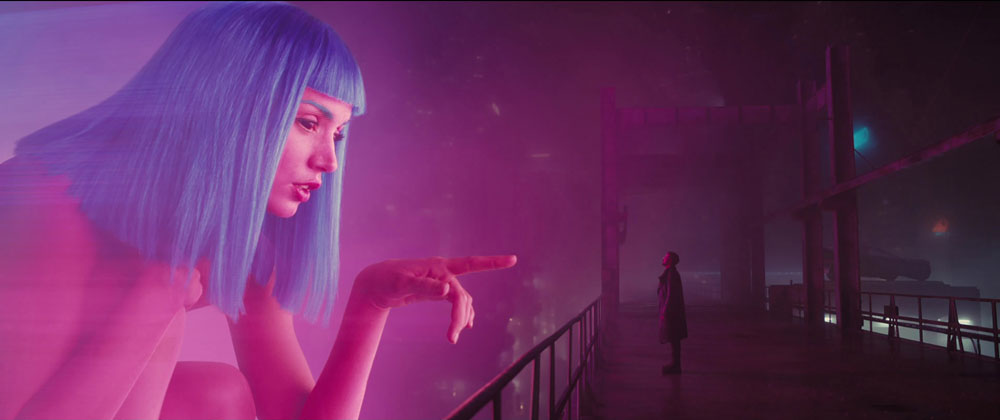 HULLFISH: She really hopes for him to be “a real boy” and there’s a moment where, faced with her own mortality, she says, “just like a real girl.”.
HULLFISH: She really hopes for him to be “a real boy” and there’s a moment where, faced with her own mortality, she says, “just like a real girl.”.
WALKER: All the characters are just looking for something real.
HULLFISH: So would you say that idea is the subtext? And how do you build that subtext into the film?
WALKER: Well, in so many of the characters there’s certainly a lot of broken dreams. Building subtext is I think about exerting the right choices. If you’re condensing a longer film to a shorter film it’s that sculpture analogy: you just don’t want to lop off an arm. Isn’t that the difficulty about editing and appreciating what we all do? We’ll never know what has been discarded and how wise that path has been. When you look at a Bernini, you don’t see the pile of rubble on the floor and get to contemplate what’s been excised or what other possibilities there might have been. We’re hopefully reducing and simmering, sometimes flambéing in musical alcohol, but always hoping not to damage the vital tissues. Here, honoring that subtext was about discarding other ideas to make space for it.
HULLFISH: Want to talk about transitions — either between storylines or otherwise?
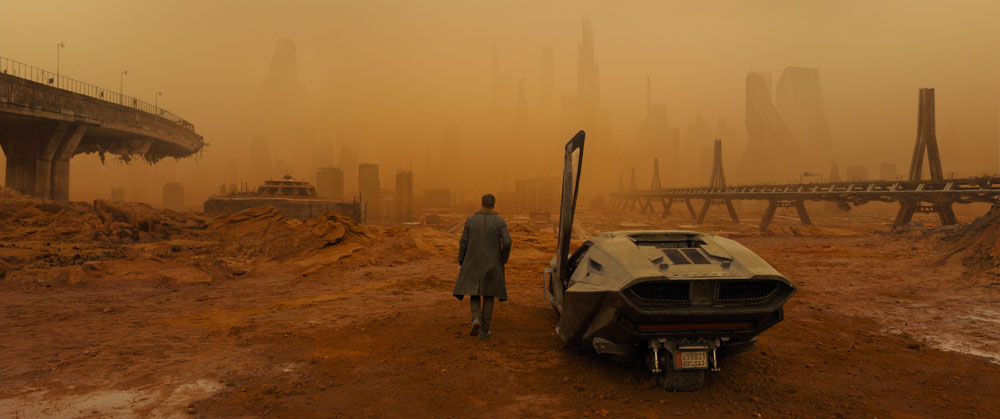 WALKER: There’s a scene where K’s been rescued by a nascent Replicant army and he’s out in the desert, badly beaten up. There’s a hallucinatory feeling as he looks across to these strange figures around a fire. The plan was to cut from the floating embers to the city – originally the meeting with Freysa was set in the abandoned Tyrell pyramid. But we felt we had to explain better that they have brought him back to LA in his spinner so that it’s available for the seawall fight. There was a fantastic test animation of the spinner landing which had no particular place in the film, and that became the basis of a shot of the spinners passing the giant Pink Joi and landing in front of a church. That choice of building was a late idea, hatched in the cutting room. I was always gripped by that cathedral St. Patrick’s in New York, this little sliver of religion dwarfed by the vast towers of commerce. Something similar felt right as the setting of a rebel army. And we got to create a mesmerizing transition from the embers of the fire into the lights of the city.
WALKER: There’s a scene where K’s been rescued by a nascent Replicant army and he’s out in the desert, badly beaten up. There’s a hallucinatory feeling as he looks across to these strange figures around a fire. The plan was to cut from the floating embers to the city – originally the meeting with Freysa was set in the abandoned Tyrell pyramid. But we felt we had to explain better that they have brought him back to LA in his spinner so that it’s available for the seawall fight. There was a fantastic test animation of the spinner landing which had no particular place in the film, and that became the basis of a shot of the spinners passing the giant Pink Joi and landing in front of a church. That choice of building was a late idea, hatched in the cutting room. I was always gripped by that cathedral St. Patrick’s in New York, this little sliver of religion dwarfed by the vast towers of commerce. Something similar felt right as the setting of a rebel army. And we got to create a mesmerizing transition from the embers of the fire into the lights of the city.
HULLFISH: Let’s talk sound.
WALKER: When choosing who would be our sound editorial team, we knew it would be a perfect marriage between Mark Mangini – who won an Oscar for his work on Mad Max Fury Road – and Theo Green who I’d known for years since working together on ‘The Escapist.’ We’d picked up on Mark’s fanatical devotion to recording original sounds – all the amazing vehicles on Mad Max for example – but we wanted to merge that with the kind of leftfield approach I knew we’d get from Theo. The blaster sound effects exemplify this: Mark recorded a whopping great big sniper rifle and Theo chipped in a 909 kick drum as a sweetener. That gives the gun a great signature. In a microcosm that’s the kind of creative match we wanted, to create sounds that we’ve never heard before.
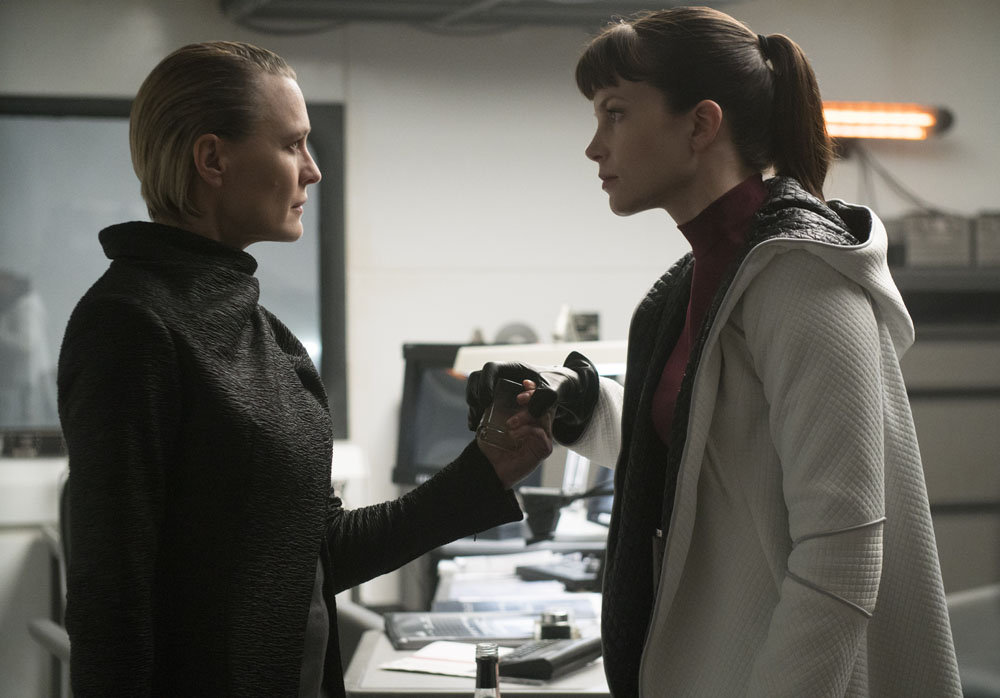 In my edit, I set out to make contrasts as sharp and intense as possible. One I love is during Luv’s violent attack on Joshi where there are some very sharp cuts… literally and editorially. At the height of the attack, we shift outside to an exterior looking in and the soundtrack plummets down to the soft sound of snow falling. I am very happy that the soundtrack preserves an idea prevalent in all the assemblies which was that it would be extremely dynamic. You could have big grand overpowering pieces of music and sound, such as the seawall sequence and yet you could also zero in on the sound of the bee beating its wings on K’s hand and an odd moment of desert silence. That’s the kind of range.
In my edit, I set out to make contrasts as sharp and intense as possible. One I love is during Luv’s violent attack on Joshi where there are some very sharp cuts… literally and editorially. At the height of the attack, we shift outside to an exterior looking in and the soundtrack plummets down to the soft sound of snow falling. I am very happy that the soundtrack preserves an idea prevalent in all the assemblies which was that it would be extremely dynamic. You could have big grand overpowering pieces of music and sound, such as the seawall sequence and yet you could also zero in on the sound of the bee beating its wings on K’s hand and an odd moment of desert silence. That’s the kind of range.
The sequence where K walks into the Las Vegas hotel is a really outstanding piece of sound. Silence isn’t enough. You have to feel a little bit of dust or plaster falling on the floor to give you a sense of space. Mark Mangini puts it very well. He says, to make a perfect white a painter has to add a tiny dash of blue. It actually takes that one contamination to kind of make it real and make you appreciate the silence. We chose not to have the sound of the dog panting when you first see it lurking in the shadows. You just have this mysterious creature you study and then the silence is broken by the most famous voice in all of cinema saying “You don’t happen to have a piece of cheese, do you boy?”
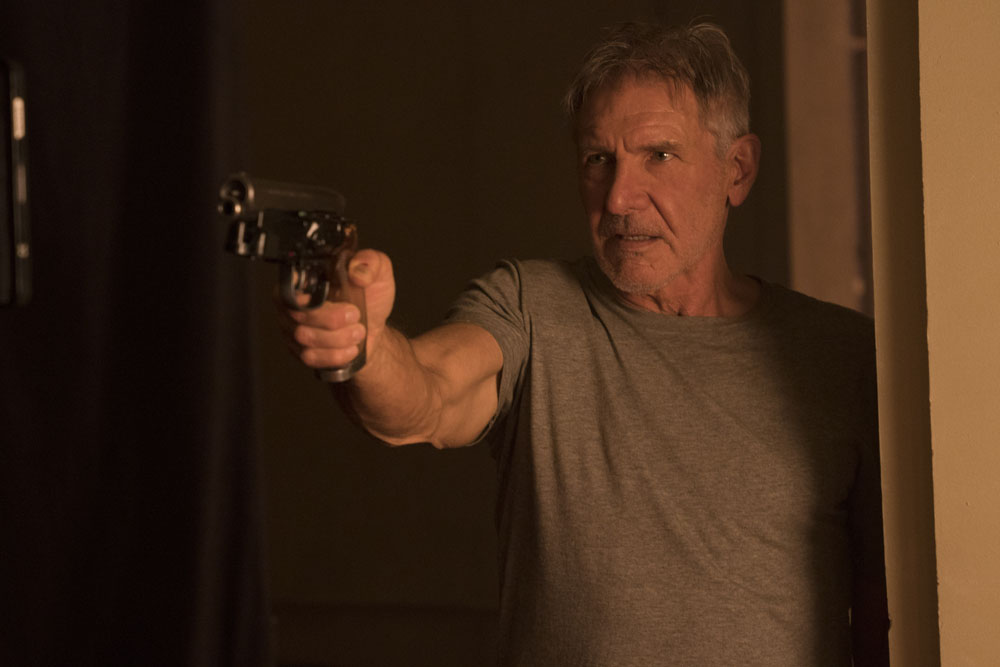
We pared down the music here, too. In the sequence where K walks through the erotic playground we had a full score at one point. Then we were going through all the stems with Clint Bennett, our fantastic music editor. There were always about 20 elements sent over by Ben Wallfisch and often we would investigate them to see what we could live without. One of the stems from this fuller piece of music was just a single stroke on a drum and that felt closer to the kind of Vangelis bombast which we wanted. So we came all the way down from the full band to one heavy drum stroke.
Also, there’s the sound of the piano luring K inside, the Brahms lullaby being played on two fingers. Sorry to boast, but by the way, that’s me!
HULLFISH: Really? Some readers may not know that you have been a sound editor, but also that you have multiple credits as a composer. So, a two finger Brahms Lullaby, huh? Uncredited I guess?
WALKER: Well, I definitely like to see myself as the rhythm section of the band, finding a way of fitting together rhythmic objects whether they’re dialogue, sound effects, music or in many cases on this film little visual elements we dropped into shots like the hologram adverts or the graphics or the dancers in Las Vegas.
Denis had chosen the piano piece, for him it represents something maternal, but we didn’t want some virtuosic performance of it. It’s Deckard playing that piano and he’s not filling concert hall seats, he’s luring K into a trap. I asked Mark Mangini, our sound supervisor if he had a real piano available and he suggested the one that lives in Formosa’s ADR suite. I took the piano apart and prepared the strings, John Cage style – we wanted to age it, so I stuck credit cards between the strings and all manner of paper clips and screws. Mark recorded it on seven or eight microphones and I kept the loud pedal down so that each note had a long sustain to it, that felt like it could curl around the corners of that grand architecture. At the end of the session, Mark told me it was “the Raiders of the Lost Ark piano”. I couldn’t remember any piano in Raiders of the Lost Ark. So he rammed his foot down on the loud pedal and screamed into the strings. It scared the living daylights out of me. If you remove the sound of the scream and just keep the sustain, that is exactly how they created that angelic effect you hear in the Nepal bar scene in Raiders, this is when Marion reveals the headpiece she has been wearing round her neck. In Hollywood, you’re never too far away from some iconic movie prop.
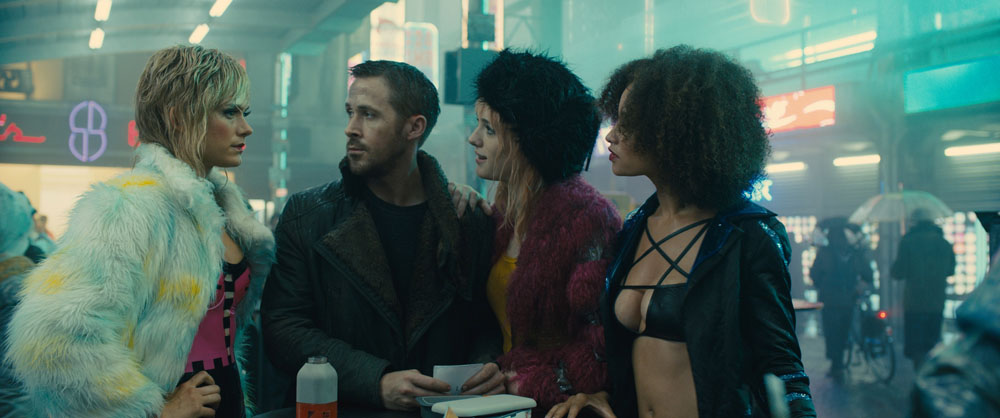 HULLFISH: The flip side of the silence, is the dynamic change of a scene like where the three prostitutes are told to go and talk to K. That was a really loud scene. From my recollection, the previous scene had been very quiet.
HULLFISH: The flip side of the silence, is the dynamic change of a scene like where the three prostitutes are told to go and talk to K. That was a really loud scene. From my recollection, the previous scene had been very quiet.
WALKER: Yes, the previous scenes are the killing of the newborn Replicant, and Gaff in the nursing home which were relatively quiet. They’re accompanied by those types of sounds that either be a sound effect or music, it’s hard to tell – a blur very true to the original film. When I obtained the bootleg album back in 2003 it was one of the few (if unofficial) soundtrack albums that pay homage to the sound design. You can’t tell whether they’re provided by the sound team or Vangelis. We really took that idea for a ride on this film.
Before I go, one sequence we didn’t talk about is the Hologram Funhouse. That was a big deal in the cutting room, and probably the hardest and longest sequence to work on. This is the scene where Deckard traps K in the nightclub and flips a switch that summons a broken hologram show to life. To gauge the scale of the operation, on that scene alone there were 21 fine cuts, just of the pre-viz. That gave us a solid idea of music for playback and a template for Roger to design his lighting. Denis and the main unit then filmed the scene for real with Deckard and K, with Ben Thompson in the background as Elvis. They shot old-school without a motion control rig. Then we had a weekend to frantically fine cut this material and then break everything down again so that we could go back to set with the 2nd unit and shoot all the holograms: the Folies Bergere, Elvis’s band, Cowgirls, Gogo dancers, Liberace, Marilyn Monroe, you name it. We had to get it right because when you cut from one angle to the other, the dancers had to do their high kicks on exactly the same beat whilst staying in sync with lighting effects already shot by Roger. That’s a really complicated thing to achieve, technically. I ended up with dozens of video tracks running for each shot and my temp team set about creating more polished versions.
So when we got back to Los Angeles, soon after Thanksgiving 2016, we sat and watched the First Assembly. Denis said, everything is fantastic, it’s going to work, except one scene: the Hologram Funhouse. We’d been toiling on that on and off for six months so it was disappointing, but I knew he was right. Tonally it didn’t fit, it didn’t feel like Blade Runner. Denis’ point was that the last time Deckard met a Replicant, it was Roy Batty, who nearly killed him. So this should be full of fear and tension. A manhunt, not a variety act. Deckard turns on those holograms because it gives him an advantage, he knows where and when the light will fall. So Denis and I recut the scene to maximize this and we dumped a lot of the layers of holograms. Really great footage of pole dancers spinning down from the ceiling, all had to go.
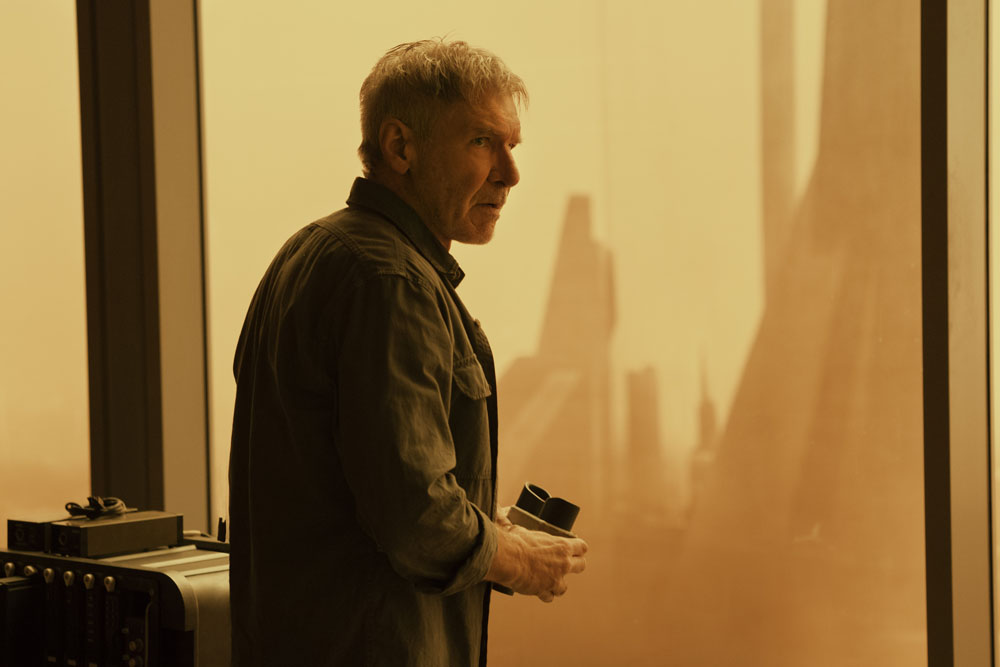
I wanted to emphasize the spookiness of this broken machine and I dug around and found some golden moments before “action” where the dancers were waiting for the playback music to start –just breathing, standing by, lit heavily from above. These ended up in the cut. We tried to put in as many dead and broken holograms as living ones.
The big transformation was dumping the music almost entirely. We just had this idea it would be creepier if just one little speaker somewhere in this vast room would suddenly spit out some audio. Theo Green our sound designer worked with me the entire length of the project. He came up with this amazing track of all the lighting units shifting and the crackling of bulbs firing up. That absolutely nailed it. Denis loved the new sequence and it was back in, but at one stage it was so far from the ‘Bladiverse’, its head was on the guillotine and we were reading it last rites.
HULLFISH: Watching it I was thinking what a nightmare to edit this scene.
WALKER: I’ll send you a screengrab that shows all the video layers. There’s one wide shot facing the stage where the plate is Deckard throwing a punch at K and the light changes very dramatically to a different routine halfway through that punch. And in that, you’ve got dozens of elements: the Folie-Bergeres dancers, the go-go dancers, Elvis and different shots of his band behind him. Then a line of cowgirls doing a kind of Cotton-Eye Joe routine. We timed it so that a cowgirl did a fantastic forward somersault which crashes through Elvis, it’s barely visible but added some chaos.
HULLFISH: Joe as usual. I loved talking to you and it’s been a great conversation. Thank you so much.
WALKER: Great talking to you about Bladerunner 2049, my friend. It’s always lovely to talk to you. I mean that.
HULLFISH: Same with you. Thanks so much for your time. I’m sure we’ll be talking about Widows at some point.
WALKER: Better get on and cut it.
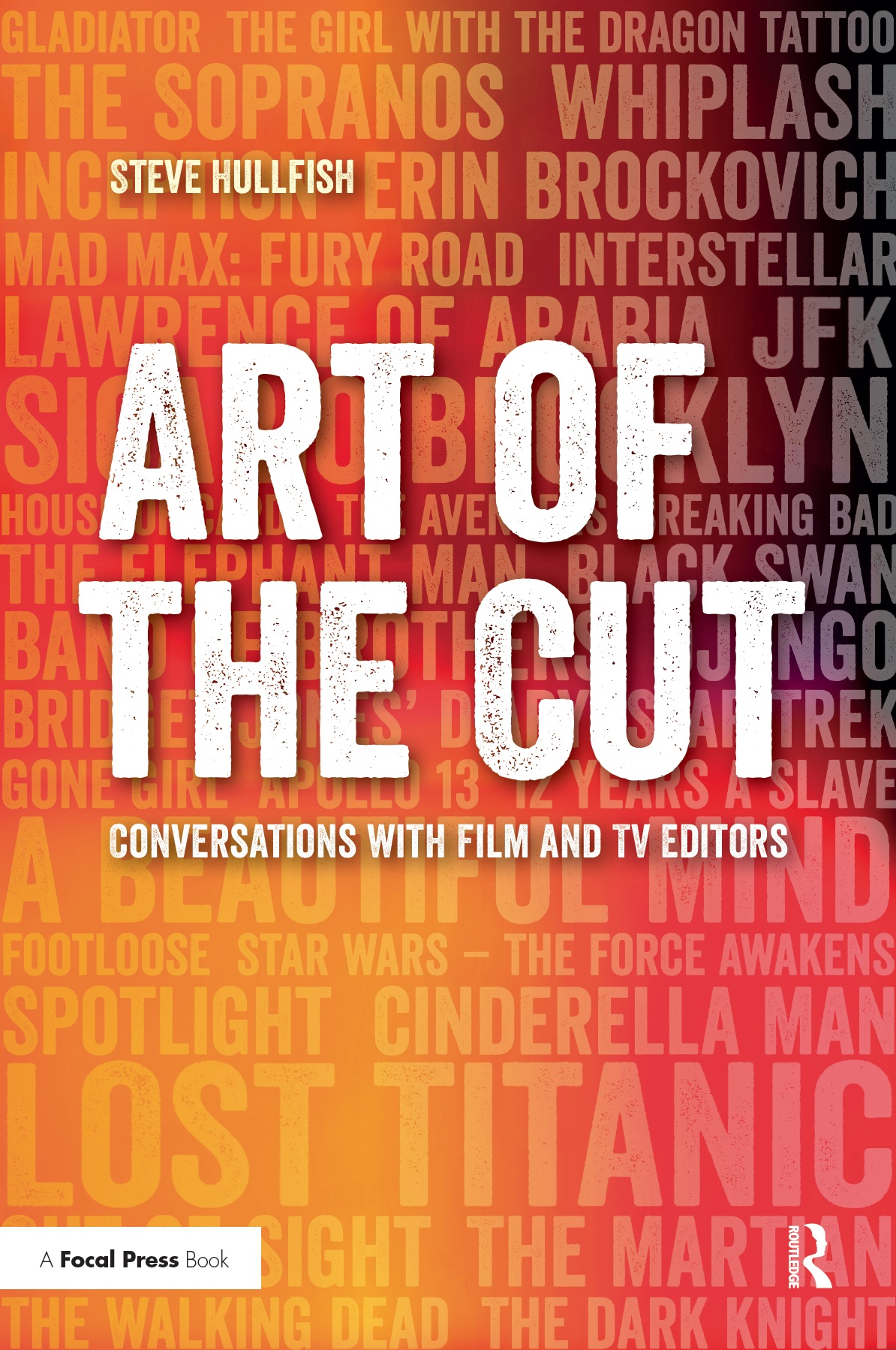 To read more interviews in the Art of the Cut series, check out THIS LINK and follow me on Twitter @stevehullfish
To read more interviews in the Art of the Cut series, check out THIS LINK and follow me on Twitter @stevehullfish
The first 50 interviews in the series provided the material for the book, “Art of the Cut: Conversations with Film and TV Editors.” This is a unique book that breaks down interviews with many of the world’s best editors and organizes it into a virtual roundtable discussion centering on the topics editors care about. It is a powerful tool for experienced and aspiring editors alike. Cinemontage and CinemaEditor magazine both gave it rave reviews. No other book provides the breadth of opinion and experience. Combined, the editors featured in the book have edited for over 1,000 years on many of the most iconic, critically acclaimed and biggest box office hits in the history of cinema.

Filmtools
Filmmakers go-to destination for pre-production, production & post production equipment!
Shop Now